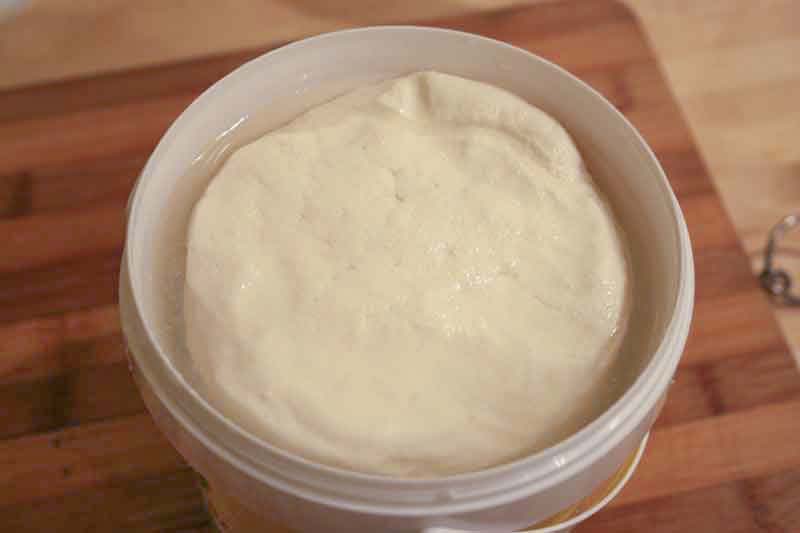
Squacquerone Cheese Making Recipe
Squacquerone is a high moisture, soft, round and wobbly cheese. Made from full fat milk, when ready the flavor travels just to the edge of sweet and tangy. Although it starts out life as a well formed cheese Squacquerone quickly transforms into a whimsically slumped shape. Yes, its life is short but it's oh so glorious when spread on bread with prosciutto or eaten on its own by the spoonful. Squacquerone is a super easy and quick cheese to make.
-
Yield
3 Pounds
-
Aging Time
None
-
Skill Level
Beginner
-
Author
Jim Wallace

Ingredients
Total price for selected items: Total price:
Instructions
Squacquerone is a classic high moisture countryside cheese. To really bring out the character of this fabulous cheese we recommend using good quality whole milk. With its high moisture content a quick ripening in the fridge for 4-5 days is all that’s needed before it’s ready to be enjoyed.
Traditionally, before refrigeration, this cheese was made during the colder months for longer preservation.
-

Heat & Acidify Milk
Slowly heat the milk to 98-100F,gently stir the milk while heating. If using pasteurized milk add calcium chloride while the milk is heating.
Once heated, sprinkle the culture over he surface of the milk. Let the culture re-hydrate for two minutes before mixing it into the milk.
Let the milk sit quietly for 30-45 minutes to allow the culture to begin working.
-

Coagulate with Rennet
Add 1.75ml of single strength liquid rennet to the milk and slowly mix in an up and down motion for one minute.
Let the milk sit quietly for 25-30 minutes while the rennet coagulates the curd.
Once done check for a firm coagulation. If the curd is still weak, let milk rest for up to 15 minutes longer. The next time you make the cheese, adjust the rennet amount if needed; more rennet for a quicker set.
-





Cut Curd
Once the milk has set well, test the curd before cutting to make sure it holds a cut with clean edges when lifted from below. Do this with the flat side of a wide knife, inserted at a 45 degree angle, and gently lift up to check for a clean split in the curd.
When ready evenly cut the curd mass into 1.5-2 inch pieces. Allow the cut curd to rest for 5-10 minutes, so the cut surfaces can heal.
After the short rest slowly stir the curds for 5-10 minutes while breaking them into 3/4 inch pieces. The key here is to go slow and be gently, if the curd cuts are too aggressive or curds are cut too small it will cause the final curd moisture to be lower than desired.
Now allow the curds to settle in the whey with no stirring for 15-20 minutes. During this time the curds will be converting lactose to lactic acid.
-

Transfer Curds to Mold
Remove the whey down to the curd level and gently transfer the curds into a basket cheese mold. Because this is a very high moisture curd, fill the mold(s) until curds are heaping over the top. As they drain the curds will settle substantially over time.
Let the curds drain for 3-6 hours, until the residual whey drains off. The amount of draining time will vary depending on the amount of moisture the curds were able to retain until this point.
Additional factors for draining time include the amount of acid the curds have developed and the temperature for draining, 68-80F is ideal.
When done, look for the rate of whey runoff and the firmness of the curd.
Once the curd mass is firm enough in the mold, it can be turned over in the mold and rest overnight. The next day it should be turned in the mold several times. A cooler 65-68F temperature is ideal at this point to keep the cheese from developing too much acidity.
-

Salting
The final cheese should still be quite jiggly, sort of like jello. Once the curd seems right keep it in the cheese mold and place it into a saturated brine for 1.5-2 hours, depending on taste. Flip the cheese over in the basket halfway through the brining time.
A simple brine formula is:
- 1 gallon of water
- 2.25 lbs of salt
- 1tbs calcium chloride
- 1 tsp white vinegar
- Bring the brine and cheese to 50-55°F before using
Find more details about brining here.
-

Finished Cheese
After brining, transfer the cheese to a plate or shallow bowl, larger than the cheese. Due to the high moisture and weak structure this cheese tends to collapse as it sits.
Once in the bowl it will quickly spread itself out. Expect anything from a slight slumping to an unorganized mass of curds and cream depending on milk and how much moisture was drained over time. Either way, don’t judge this cheese by it’s cover, no matter how it looks it’s truly delightful.
Store your finished Squaquarone in the fridge to ripen for 4-5 days. When finished this cheese should stay in the fridge and be enjoyed within 5-7 days.
The final texture will be spreadable and the flavor should be that of fresh milk with a slight sweetness or mild acid. Imagine a blend between Cream Cheese, Mascarpone and Ricotta.
Cheese Making Supplies
Related Products
You May Also Like




































